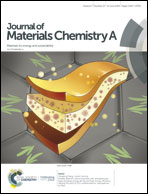In situ growth of a POMOF-derived nitride based composite on Cu foam to produce hydrogen with enhanced water dissociation kinetics†
Abstract
Dispersing active materials on a working electrode without any binder is always desirable for electrocatalytic processes. Here we report a promising method to grow polyoxometalate-based MOFs (POMOFs) in situ on a copper foam (CF) substrate. Impressively, CF can serve as metal nodes for the direct growth of MOFs on its 3D skeleton tightly. After ammoniating the POMOFs/CF precursor, a nitride-based composite (MoN–Cu-NPC/CF) is achieved with such a unique structure with MoN and Cu nanoparticles embedded in N, P-doped amorphous carbon and decorated on CF uniformly. We find that MoN–Cu-NPC/CF has an improved HER activity over a wide pH range. Especially in an alkaline electrolyte, this composite shows a small onset overpotential of 60 mV, a Tafel slope of 152 mV dec−1 and an outstanding long-term stability (over 20 h), outperforming most of the nitride-based HER electrocatalysts to date. Density functional theory (DFT) calculations reveal that the synergy between MoN and Cu can modify the electronic structure of the active Cu sites, which significantly improves H* binding and water dissociation kinetics. This work provides a facile strategy for in situ growth of MOFs on a metal substrate without any binder and holds substantial promise for efficient HER applications.



 Please wait while we load your content...
Please wait while we load your content...